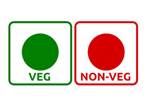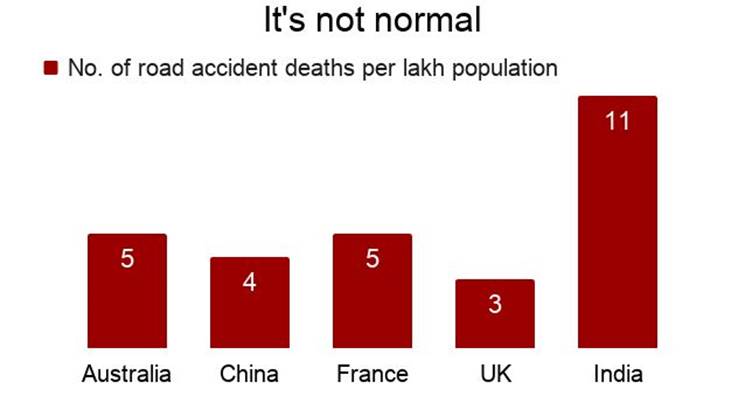



There should be “One Nation One Standard†similar to “One Nation One Constitution†and “One Nation One Ration Cardâ€: Shri Ram Vilas Paswan
To ensure quality products available to all consumers across the country.
- It should be set up as per global benchmarks.
- It should be applicable on imported items too.
- The Bureau of Indian Standards (BIS) is the national standards body of India working under the aegis of Ministry of Consumer Affairs, Food & Public Distribution, Government of India.
- BIS is a National Standards body, vested with residuary powers.
- All other standard making bodies must work in coordination with BIS.
- Standard set for Bullet Proof Jackets in India is higher than global benchmarks and India is only the 4th country in the world to have such a standard after USA, Germany and UK.
- It is established under the Bureau of Indian Standards Act, 1986.
- The Minister in charge of the Ministry or Department have administrative control of the BIS and act as the ex-officio President of the BIS.
- Any product that has the ISI mark is supposed to be of minimum standard and safe for use by consumers.
- The ISI mark is both mandatory and voluntary.
- Some mandatory ISI certification products include cement, electrical appliances, LPG cylinder, Batteries, Oil pressure stove, Automobile Accessories, Medical equipment, steel products, Stainless Steel, Chemicals, Fertilizers, infant foods and packaged drinking water.
- Directorate of Marketing and Inspection, an agency of the Government of India, do the Agmark certification of agricultural commodities for the benefit of consumers and producers/manufacturers.
- There are some 205 different commodities including Pulses, Cereals, Essential Oils, Vegetable Oils, Fruits and Vegetables, and semi-processed products that have to have an AGMARK.
- The scheme is legally enforced by Agricultural Produce (Grading & Marking) Act, 1937.

- As per Food Safety & Standards (Packaging & Labelling) Regulations, 2011
- Provided also that the provisions of above regulation shall not apply in respect of mineral water or packaged drinking water or carbonated water or alcoholic drinks, or liquid milk and milk powders.
- Bureau of Indian Standards (BIS) launched the hallmarking scheme on behest of the Government of India, for gold in the year 2000 and for silver jewellery in 2005.
- The scheme is voluntary in nature.

- In 2006, the Bureau of Electrical Efficiency (BEE) of Ministry of Power, Government of India, launched a scheme for BEE star on labels.
- The BEE star label has been applicable for electrical products.
- To sell an electrical product, a minimum 1 Star rating is mandatory.
- The Government of India introduced the Handloom Mark scheme to promote handloom products in the domestic and international markets and to provide assurance to consumers about the genuineness of handloom products.
- A consumer having any doubt about the authenticity of a product labelled with Handloom Mark can approach the Textiles Committee of Government of India with a copy of the bill and the code number of the mark.
- The mark is in two forms: the one for domestic use has the word ‘handloom’ written beneath the logo, and the one for international marketing has the same logo with the words ‘hand woven in India’ written beneath it.
- Eco mark is a certification mark issued by the Bureau of Indian Standards (the national standards organization of India) to products conforming to a set of standards aimed at least impact on the ecosystem.
- This is not a mandatory quality mark but is advisory.
- FSSAI is not an obligatory certification mark but it signifies that food is hygienic and meets the approved safety standards set for food items under the Food Safety and Standards (FSS) Act, 2006 .
- The Bureau of Energy Efficiency (BEE) has introduced a new star-rating methodology called Indian Seasonal Energy Efficiency Ratio (ISEER) for air conditioners.
- This methodology factors in variance in higher temperatures in India and rates air conditioners accordingly.
Source: PIB
- The facility for enrollment under the scheme has been made available to the prospective beneficiaries through 3.50 lakh Common Service Center (CSCs) across the country.
- At the time of enrolment, the beneficiary is required to have an Aadhaar card and a saving bank/ Jan-dhan Account passbook only.
- He/ She should be within 18 to 40 years of age group.
- GSTIN is required only for those with turnover above Rs. 40 lakhs.
- The enrolment under the scheme is free of cost for the beneficiaries.
- The beneficiary should not be income tax payer.
- He should not be a member of EPFO/ESIC/NPS (Govt.)/PM-SYM.
- The Central Government shall give 50 % share of the monthly contribution and remaining 50% contribution shall be made by the beneficiary.
- This scheme will target enrolling 25 lakh subscribers in 2019-20 and 2 crore subscribers by 2023-2024.
- What will happen if they forget to make their contribution. Will government compensate for their contribution or penalize them.
- There will be issues in identifying the traders.
- It is just an extension of Atal Pension Yojana.
- It is a voluntary scheme than being the mandatory one. Government should have made it statutory and mandatory so that no future government can throw it out.
- What will happen if future turnover crosses Rs. 1.5 Crore. Will government stop the pension.
Source: PIB
T462 Ekalavya Model Schools are launched across the country in Tribal Dominated Areas. The schools would focus to provide quality upper primary, secondary and senior secondary level education to Scheduled Tribe students in these areas.
- It will facilitate education.
- It will protect local art and culture.
- It will promote skill development in tribal children.
- There will be an autonomous society under the Ministry of Tribal Affairs to run the Eklavya schools which will be similar to Navodaya Vidyalaya Samiti.
- Every block with more than 50% ST population and at least 20,000 tribal persons, will have an EMRS ( Eklavya Model Residential school).
- Lack of modern facility, infrastructure quality at the schools.
- Issue of language: Tribals are not fluent with either Hindi or English but the syllabus are mostly prescribed in these two languages.
- Issue of malnutrition : Tribals face higher burden of malnutrition which affects their cognitive faculty.
- Higher prevalence of poverty, lack of education among parents, remote location also affects their mobility and learning.
- Many tribals areas are inflicted with Naxalism and violence which discourages good teacher to take up the job or closes down the school for many days.
- Poor policy implementation regarding opening of schools, prevalent corruption in education system affects the education.
- These schools should be associated with firms focussing on related skills development.
- Increased transparency and accountability in the working of schools will strengthen the school infrastructure.
- Syllabus needs to be developed in mother tongue for better understanding. Article 350 also exhorts government to do the same.
- Proper implementation of Mid day meal scheme along with faster development of tribal areas will encourage students to take up education seriously.
Source: Pib
A road accident happens every minute in India in which at least one person is injured and every third accident claims a life, on an average.
- Using Mobile Phones while driving
- Drunken driving/consumption of alcohol/ drug.
- Overloaded vehicle.
- Poor light condition.
- Jumping red light.
- Neglect of civic bodies.
- Weather condition.
- Driving on wrong side.
- Defect in road condition.

- Government made it mandatory for car or two-wheeler buyers to get a three-year or five-year insurance policy.
- There's now a scheme to set up a trauma centre every 100 km on national highways.
- Good Samaritan Law (enacted in 2015) so that people can help victims.
- The new Motor Vehicles Act, which has led to a steep increase in penalty for traffic violations is an attempt to tackle the cause of the problem-bad drivers.
- Steep increase in people buying the licenses.
- Increases sale of the Helmets.
- Renewing or making of the licenses.
- Following of the traffic lights.
Source: https://timesofindia.indiatimes.com/india/timestopten.cms
An exoplanet with temperatures that can potentially support life, now found to have water vapour too.
- About 110 light years from Earth, an exoplanet eight times the mass of Earth orbits a star.
- Now, scientists have found signatures of water vapour in the atmosphere of K2-18b.
- It is the only planet orbiting a star outside the Solar System that is known to have both water and temperatures that could support life.
- K2-18b’s size and surface gravity are much larger than Earth’s.
- Its radiation environment may be hostile too.
- It is significantly heavier and has a different atmospheric composition.
- The researchers used 2016-17 data from the Hubble Space Telescope and developed algorithms to analyse the starlight filtered through K2-18b’s atmosphere.
Indian and Chinese soldiers had a heated exchange in Ladakh near the Pangong Tso lake. Differing perceptions about the Line of Actual Control (LAC) was responsible for the incident.
- Pangong Tso is a long narrow, deep, endorheic (landlocked) lake situated at a height of more than 14,000 feets in the Ladakh Himalayas.
- The 135 km-long lake sprawls over 604 sq km in the shape of a boomerang, and is 6 km wide at its broadest point.
- The brackish water lake freezes over in winter, and becomes ideal for ice skating and polo.
- The LAC cuts through the lake, but India and China do not agree on its exact location.
- As things stand, a 45 km-long western portion of the lake is in Indian control, while the rest is under China’s control.
- It lies in the path of the Chushul approach, one of the main approaches that China can use for an offensive into Indian-held territory.
- During the 1962 war, this was where China launched its main offensive — the Indian Army fought heroically at Rezang La, the mountain pass on the south-eastern approach to Chushul valley.
- The Chinese have built motorable roads along their banks of the Pangong Tso. It points to the importance accorded by the Chinese to the area.
- In 1999, when the Army unit from the area was moved to Kargil for Operation Vijay, China took the opportunity to build 5 km of road inside Indian territory along the lake’s bank.
- The 1999 road added to the extensive network of roads built by the Chinese in the area, which connect with each other and to the G219 Karakoram Highway.
- On the water, the Chinese had a major advantage until a few years ago, but India purchased better boats some seven years ago, leading to a quicker and more aggressive response.

© 2025 iasgyan. All right reserved